Physical Address
304 North Cardinal St.
Dorchester Center, MA 02124
The relationship between the joints, ligaments, tendons, and fascia of the foot, ankle, and lower extremity allows weight-bearing athletes to perform extraordinary feats of power, speed, and endurance. In this chapter, motion of various foot and ankle segments (kinematics) and the forces experienced by the lower extremity (kinetics) are explored over the gait cycle. Special attention is given to the biomechanical mechanisms by which the components of the foot and ankle interact. The biomechanics of walking are compared with running, and clinical correlations are made throughout the chapter.
Gait consists of a cyclical series of whole body motions incorporating pelvic sway and rotation, hip and knee swing, tibia rotation, and ankle flexion and extension. A single iteration of the gait cycle is often described as occurring between initial ground contact of one step and the initial ground contact of the same foot on the subsequent step. A single cycle can be divided into a stance phase and a swing phase ( Fig. 110.1 ). The stance phase of walking can also be divided into three intervals: the first interval extends from initial ground contact (typically heel strike) to the foot lying flat on the floor; the second interval occurs as the body passes over the flat foot; and the third interval extends from the moment the heel rises from the floor to when the toes lift from the floor. These intervals may also be referred to as rockers.
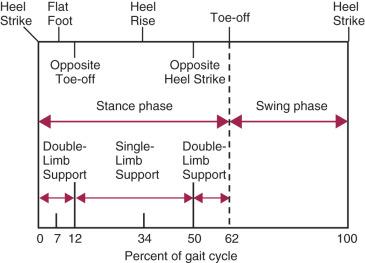
Changes in the gait cycle during running are illustrated in Fig. 110.2 . During walking, the stance phase contains periods of double- and single-limb support, with one foot always in contact with the ground. As the speed of gait increases, a transition occurs with incorporation of a float phase, during which both feet leave the ground. As the speed of running increases, the duration of the stance phase, both in real time and in percentage of the gait cycle, decreases and the duration of the float phase as a percentage of the gait cycle increases.
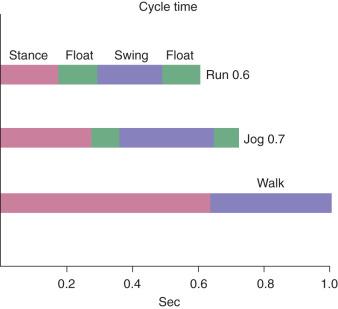
Kinematics describes the motion of body segments. The coordinated motion of the pelvis, hip, knee, ankle, and hindfoot is well preserved between individuals, although factors such as age, gender, body mass index, leg length, speed, training, and fatigue may alter its characteristics.
The rhythmic vertical displacement of the body is a necessary component of bipedal locomotion. The center of gravity of the body moves in a smooth sinusoidal path with amplitude of approximately 4 to 5 cm and reaching its peak immediately after passage over the weight-bearing leg. Minimizing vertical displacement of the body's center of gravity during gait minimizes energy expenditure and is an important aspect of whole body biomechanics. As the foot strikes the floor, the knee flexes against an eccentric contraction of the quadriceps muscle, the ankle plantar flexes against an eccentric contraction of the anterior tibial muscle, and the hindfoot pronates. Next the center of gravity moves upward as the body moves over the stance leg. The stance leg functionally elongates through knee extension and plantar flexion of the ankle as the heel rises from the floor and the foot supinates.
Lateral and axial translation and rotation are also components of whole body motion during gait. The body shifts laterally over the weight-bearing leg, with each step creating a sinusoidal displacement of approximately 4 to 5 cm. The degree of lateral translation of the body's center of gravity is related to the degree of lateral deviation of foot placement from the central line. A series of axial rotations begin in the pelvis and traverse the femur and tibia. The tibia rotates internally during swing phase and into the beginning of stance phase and externally during the later period of stance. The degree of these rotations is subject to marked individual variations, with an average of 19 degrees and ranging between 13 and 25 degrees during a gait cycle.
The functions of the ankle, subtalar, transverse tarsal, and metatarsophalangeal joints interrelate closely to fulfill the varying requirements of the foot during walking and running. At initial ground contact, a complex set of energy absorption mechanisms helps to lessen the shock wave that propagates up the axial skeleton. Later in stance, passive and active mechanisms alter the structure of the foot to provide the body with a stable platform and to functionally elongate the stance limb, allowing for a greater stride length. During walking, the toes are lifted from the floor, whereas in athletics, forceful push-off facilitates rapid acceleration and deceleration, directional change, and jumping.
The stresses applied to the joints of the foot and ankle vary greatly from normal walking to athletics. The stresses can be repetitive, as in a long-distance runner, or impulsive, as occurs in the push-off foot of a shot-putter. The whole-body vertical force involved in running is 2 to 2.5 times body weight compared with 1.2 times body weight in walking and can be higher for many sports with extreme push-off, such as a football lineman engaged in blocking or a basketball player engaged in rapid accelerating and jumping activities ( Fig. 110.3 ). The force applied across the ankle joint during walking is approximately 4.5 times body weight. This maximum stress occurs during the flat foot portion of the stance phase as the body moves over the stance limb. If this force were extrapolated to running, in which the ground reaction force is more than double that of walking, we would see stress across the ankle joint that approaches 10 times body weight. Training and modification of running technique can affect these parameters.
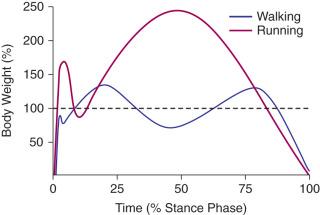
The foot and ankle complex must be supple enough to absorb impact and rigid enough to transmit muscle forces, or injuries such as sprains, strains, stress fractures, and fascial tears may result. Dysfunction of the foot and ankle complex may result in an altered gait pattern, declining athletic performance, and compensatory changes in the knee and hip joints. Athletic training can help to attenuate these forces and minimize the risk of injury. The ankle and hindfoot joint complex function as a universal joint, linking pelvic, thigh, and leg rotation to hindfoot motion and longitudinal arch stability, which allows the ankle joints to compensate for some degree of dysfunction in the hindfoot and vice versa. However, athletics require maximum performance from these systems, and dysfunction of ankle and foot mechanics often leads to pain, injury, and loss of performance.
Stresses about the foot and ankle are measured in a variety of ways, including static modalities such as the Harris-Beath mat or a standing pressure sensitive grid, and dynamic modalities such as force plate analysis or a thin film pressure transducer placed in a shoe. The nature of these stresses depends on the activity and includes vertical force, fore and aft shear, side-to-side shear, and torque. A measurement method should be chosen based on the type of data required, such as static versus dynamic, whole body versus discrete point, and barefoot versus in shoe.
During the gait cycle, the ankle joint's sagittal plane motion spans 20 degrees of dorsiflexion to 50 degrees of plantar flexion, with marked variability between individuals, along an axis running between the tips of the malleoli. The trochlear surface of the talus rotates around this axis, as would a section from a cone whose apex is most frequently described as based medially ( Fig. 110.4 ), although data from CT scans suggest may be based laterally. Two series of dorsiflexion and plantar flexion occur during the gait cycle when walking. At heel strike, the dorsiflexed ankle rapidly plantarflexes. This motion ends with the foot flat on the floor, after which progressive ankle dorsiflexion occurs as the body moves over the fixed foot. Dorsiflexion reaches a maximum at 40% of the walking cycle, when ankle plantar flexion begins as the heel rises, and continues until toe-off, when dorsiflexion occurs again during the swing phase ( Fig. 110.5 ).
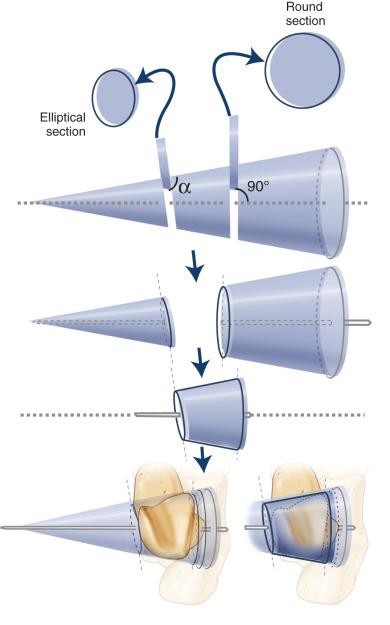
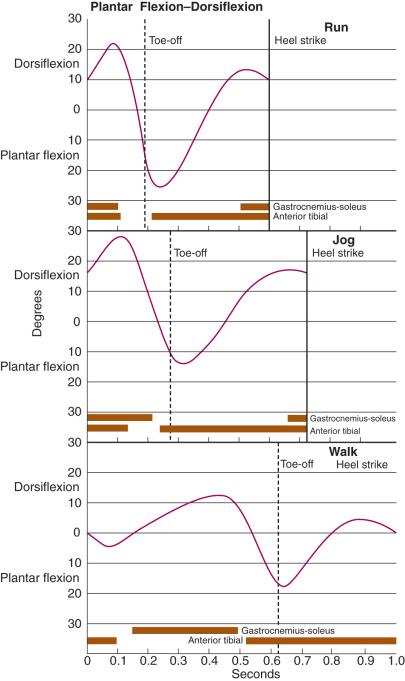
The talus is stabilized within the ankle mortise by bony and soft tissue restraints. The congruity of the ankle mortise leads to considerable inherent bony stability. Ligament support includes the deltoid ligament medially and three separate ligamentous bands laterally: the anterior and posterior talofibular ligaments and the calcaneofibular ligament. The anterior talofibular ligament is taut with the ankle joint in plantar flexion, and the calcaneofibular ligament is taut with the ankle joint in dorsiflexion ( Fig. 110.6 ). The anterior talofibular ligament is injured most frequently during ankle sprains, in part because the ankle has less intrinsic bony stability in plantar flexion when this ligament is under tension. Injuries to the calcaneofibular ligament are frequently seen in conjunction with anterior talofibular ligament sprains.
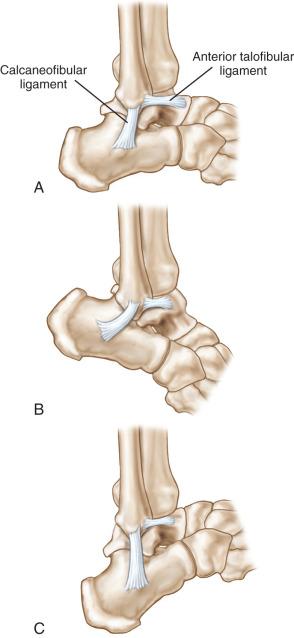
Muscle control of the ankle joint can be divided based on the anterior and posterior leg muscle compartments and the phases of the gait cycle. The lateral compartment muscles function with the posterior compartment. During normal walking, the anterior compartment muscles become active late in the stance phase and in the swing phase to bring about dorsiflexion of the ankle joint by a concentric (shortening) contraction (see Fig. 110.5 ). This muscle group remains active after heel strike to control the rapid plantar flexion of the ankle joint that occurs by an eccentric (lengthening) contraction. This eccentric contraction during plantar flexion helps to dissipate the forces on the limb at initial ground contact. The anterior compartment ceases contraction by the time the foot is flat on the floor.
The posterior compartment muscles are active after the foot is flat (15% to 20% of gait cycle), during which time the ankle joint is undergoing dorsiflexion, and they remain active until approximately halfway through the cycle, at which time approximately 50% to 60% of ankle joint plantar flexion has occurred. This muscle group initially undergoes an eccentric contraction slowing forward movement of the tibia over the foot, then a concentric contraction when plantar flexion begins. The posterior calf group ceases contraction before full plantar flexion has occurred as the opposite limb accepts weight bearing, indicating that the last portion of plantar flexion is a passive phenomenon.
As the speed of gait increases to running and sprinting, and a period of double-limb support gives way to a period void of limb support, several changes occur. Most notably, at heel strike when running, the other foot is not in contact with the ground, and as running speed increases, the duration of stance phase reduces significantly. The ankle joint starts in slight dorsiflexion and, at heel strike, remains dorsiflexed (see Fig. 110.5 ). Rather than the ankle plantarflexing after heel strike as is seen in a walking gait, the foot-flat position is achieved while the ankle remains dorsiflexed by the tibia moving forward over the foot. The anterior compartment muscle contraction still begins late in stance and continues through swing, but during running it lasts through approximately the first third of the stance phase. The posterior calf muscle groups show a significant change in activity; they begin to contract late in the swing phase and remain active until approximately halfway through ankle joint plantar flexion. This increased activity in the posterior calf musculature probably serves to stabilize the ankle joint at the time of initial ground contact.
Understanding the kinematics of running is important for maximizing performance and minimizing risk of injury. Sprinters fastest start times are recorded when they orient their ground reaction force toward a horizontal inclination, partially by increasing dorsiflexion of the ankle. Kinematics patterns differ between recreational and elite runners, with parameters such as pelvic tilt, knee flexion, and ankle eversion in late stance adapting to improve performance. Injury risk in collegiate cross-country runners over a season is associated with preseason peak external knee adduction moment (KAM) and peak ankle eversion velocity. Age older than 40 years is associated with diminished angular motion of the ankle, knee, and pelvis compared with younger runners. Increasing speeds in these runners is explained by increased hip angular displacement, which may put added stress on the hamstring and Achilles tendons.
Midfoot and forefoot strike patterns during running, more amenable to bare feet or shoes with minimal heel padding, alter kinematics and kinetics of the ankle compared with a heel-strike running pattern. Running in shoes with less heel padding or barefoot favors the foot contacting the ground with more plantar flexion at the ankle, initially striking either the midfoot or forefoot. Midfoot or forefoot strike patterns are associated with shorter stride length and higher stride frequency. Flatter foot placement at touchdown correlates with lower peak heel pressures but significantly higher leg stiffness during the stance phase. Tibial internal rotation excursion is similar. Posterior compartment muscle force output is greater in forefoot striking than in rearfoot striking and in barefoot than in shod running, although Achilles tendon strain is lower while running barefoot than while running when wearing a standard shoe. As speed of running increases in shoes with minimal heel padding, work is redistributed from the knee to ankle compared with shoes with more heel padding.
Running with forefoot and rearfoot strike patterns requires similar oxygen uptake and internal mechanical work, with slight increased metabolic demand in shod runners explained by an approximately 1% increase in metabolic demand for each 100 g of added shoe weight. Despite no difference in internal work, an increase in external and total mechanical work occurs in forefoot strike runners, which perhaps is explained by higher storage and release of energy in the elastic structures of the lower leg. Another way to look at this is that traditional shoes with padded heels attenuate the foot-ground impact, which may decrease the capacity for storage and restitution of elastic energy by the leg, resulting in lower net efficiency in shod running compared with minimal-shoe running.
Although runners will fervently defend their strike pattern, objective demonstration of practical differences remains elusive. There is no association between strike pattern and race time during marathons, although a large number of runners switched from a midfoot pattern at 10 km to a heel strike pattern at 32 km, perhaps related to fatigue or pace. In a study of 52 middle- and long-distance collegiate runners, those with rearfoot strike patterns (two-thirds of the group) had approximately twice the rate of repetitive stress injuries than did runners who habitually had a forefoot strike, although a number of other covariates were present, including gender, race distance, and average miles per week; traumatic injury rates were not significantly different between the two groups. Anecdotal reports suggest forefoot striking may help people with chronic exertional compartment syndrome, but it may be associated with the development of metatarsal stress fractures.
Clinically relevant conditions may also benefit from an understanding of their associated biomechanics. Patients with insertional Achilles tendinopathy do not have diminished non–weight-bearing dorsiflexion or isometric plantar flexor strength. Instead, altered ankle biomechanics during stair ascent produce greater symptom severity and likely contribute to decreased function. Achilles tendon stiffness after repair may contribute more to loss of plantar flexion power than tendon elongation. When we speak of ankle joint dorsiflexion and plantar flexion, only approximately half of this motion comes from the ankle joint; the remainder comes from the movement occurring within the subtalar and transverse tarsal joints. If motion of the ankle joint is diminished, perhaps from an anterior impingement, osteoarthritic changes, or surgical fusion, the subtalar and transverse tarsal joints compensate for the lost motion. If degenerative changes occur within the subtalar or transverse tarsal joints, any loss of ankle joint motion is magnified. This compensatory increase in motion of the neighboring joints is nonphysiologic and often leads to pain, loss of function, increased energy expenditure, and degenerative changes over time.
The terms pronation and supination describe a coordinated series of movements linking the tibia, ankle joint, subtalar joint, transverse tarsal joints, metatarsophalangeal joints, and plantar aponeurosis. It is this linked series of movements that enable the athlete to absorb the forces of impact, yet create a rigid platform from which to push off ( Table 110.1 ).
| FOOT POSITION | ||
|---|---|---|
| Pronation | Supination | |
| Joint position | Ankle dorsiflexion | Ankle plantarflexion |
| Subtalar eversion | Subtalar inversion | |
| Transverse tarsal abduction | Transverse tarsal adduction | |
| Arch stiffness | Supple | Rigid |
| Gait cycle | Heel strike | Flat foot to toe-off |
| Function | Energy absorption | Energy transfer to ground |
The subtalar joint permits inversion and eversion. The axis of the subtalar joint varies between athletes but is approximately 42 degrees to the horizontal plane and passes from medial to lateral at approximately 23 degrees ( Fig. 110.7 ). The range of motion of the subtalar joint spans approximately 30 degrees of inversion to 15 degrees of eversion, although measurement of subtalar joint motion is difficult. Although the pattern of motion appears to be consistent between individuals over the gait cycle, the magnitude of motion varies considerably.
![Fig. 110.7, Variations in the subtalar joint axes. In the horizontal plane (A), the axis approximates 45 degrees and (B) passes approximately 23 degrees medial to the midline. ([A] and [B], Fig. 110.7, Variations in the subtalar joint axes. In the horizontal plane (A), the axis approximates 45 degrees and (B) passes approximately 23 degrees medial to the midline. ([A] and [B],](https://storage.googleapis.com/dl.dentistrykey.com/clinical/FootandAnkleBiomechanics/6_3s20B9780323544733001102.jpg)
The subtalar joint, which is stabilized primarily by the complex joint configuration of the anterior, middle, and posterior facets and by the interosseous talocalcaneal ligament, is less constrained than the ankle. When the long axis of the tibia passes medial to the obliquely placed subtalar joint axis, subtalar joint eversion ceases because of the configuration of the joint surfaces and the interosseous ligament. When the weight-bearing line is lateral to the subtalar joint axis, inversion stability depends on lateral ligament support and active muscle function.
The subtalar joint has been likened to an oblique hinge that functions to translate motion between the transverse tarsal joint distally and the ankle joint and leg proximally ( Fig. 110.8 ). At the time of initial ground contact during walking, the slightly inverted subtalar joint undergoes rapid eversion, the tibia undergoes internal rotation, the transverse tarsal joints become supple, and the medial longitudinal arch flattens. These passive movements combine to help dissipate the energy imparted to the foot during heel strike.
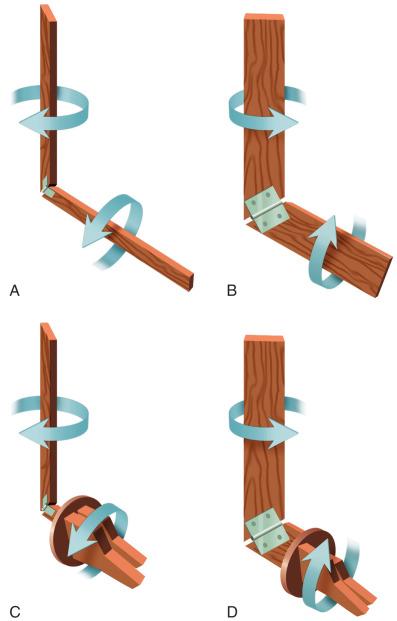
This linkage is also important for efficient energy transfer during heel rise and toe-off, which involves both passive and active mechanisms. During the flatfoot phase, the subtalar joint undergoes progressive inversion, which reaches a maximum at toe-off. This movement increases the stability of the transverse tarsal joints and medial longitudinal arch, stiffening the foot and allowing it to act as a rigid extension of the leg. Pelvis rotation causes an external rotation torque, which is transmitted from the lower extremity across the ankle joint and is translated by the subtalar joint into hindfoot inversion. The plantar aponeurosis mechanism and the oblique metatarsal break enhance the inversion, as will be described later.
To best appreciate how various muscles affect the subtalar joint, examine the size and location of the muscles in relation to the subtalar joint axis ( Fig. 110.9 ). In general, tendons passing medial to the axis produce inversion, whereas tendons passing laterally produce eversion, although these functions are affected by the starting position of the subtalar joint. The main inverters are the tibialis posterior and the gastrocnemius-soleus complex, and the main everter is the peroneus brevis and, to a lesser extent, the peroneus longus, which is mainly a plantar flexor of the first metatarsal. The tibialis anterior lies close to the subtalar joint axis and provides little influence on the neutral subtalar joint. However, it is the only functioning muscle at heel strike and may resist eversion of the initially inverted subtalar joint. The patient who lacks posterior tibial tendon function cannot initiate standing on tiptoe but can maintain the position when it is achieved. It may be concluded that posterior tibial tendon function is necessary to initiate inversion and that the gastrocnemius-soleus complex is necessary to maintain it. During running, the posterior calf muscles become active late in swing phase and remain active through most of stance (see Fig. 110.5 ). Besides providing stability to the ankle joint, these muscles contribute to inversion of the subtalar joint before initial ground contact.
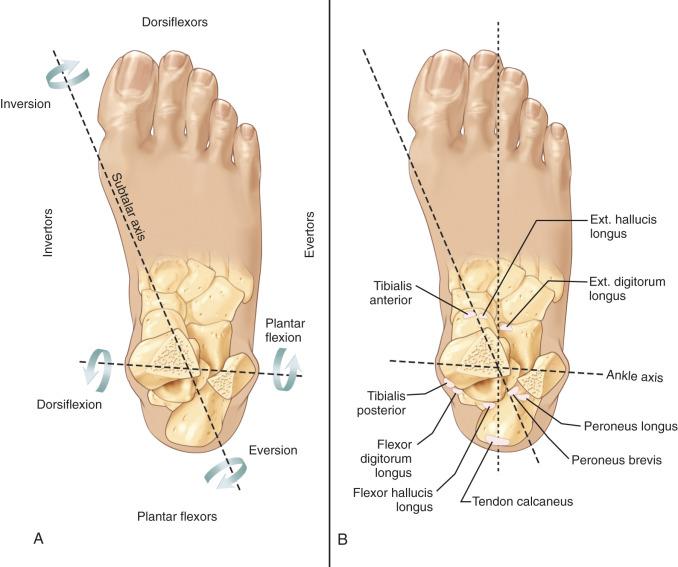
If the motion in the subtalar joint is restricted, its ability to translate rotation proximally and distally is impaired, placing increased stress on the ankle and transverse tarsal joints. For example, talocalcaneal coalition can lead to a spastic peroneal flatfoot or ball-in-socket ankle because of the lack of subtalar motion. The degree of ankle joint dorsiflexion and plantar flexion also is affected, and the ankle can become arthritic from the abnormal stresses.
Foot morphology plays a role in hindfoot motion and force attenuation during the gait cycle. For instance, people with flat feet have increased eversion of the subtalar joint during stance ( Fig. 110.10 ). This eversion translates to increased tibial internal rotation, which can affect knee alignment, patellofemoral tracking, or the hip in selected cases. The theory behind orthotic use for many conditions involving the foot, ankle, knee, hip, and back is the effect they have on the linkage system within the lower extremity. The use of a medial heel wedge, whether built into the shoe or within an orthotic device, may influence the rotation of the subtalar joint, which may decrease the degree of internal rotation or adduction moment transmitted to the lower extremity, which in turn may have a beneficial effect on the forces across the ankle, knee, and hip. For instance, a runner with chronic anterior knee pain may be helped by an orthotic device that limits eversion of the calcaneus, which in turn diminishes internal rotation of the tibia and affects patellofemoral tracking. However, reliable data to support this theory are lacking ; the benefit may in part be psychological, and soft orthoses and compliant shoe material may simply help to absorb the impact of initial ground contact.
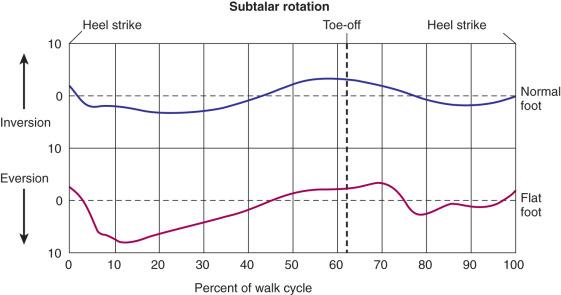
Other clinical conditions may also benefit from shoe inserts that control hindfoot motion or attenuate impulsive forces. Laterally based heel wedges reduce KAM in patients with varus knee arthritis, regardless of walking speed. Material that helps to absorb impact can also be beneficial for persons engaged in repetitive sports, such as long-distance running, especially if the athlete is having problems such as heel pain, metatarsalgia, or shin splints. However, softer material paradoxically can lead to greater vertical load when landing from jumps as the athlete stiffens the limb in an attempt to improve balance and stability.
The transverse tarsal joint, consisting of the talonavicular and calcaneocuboid joints, lies distal to the subtalar joint and is influenced strongly by subtalar position. The function of the plantar aponeurosis, the transverse metatarsal break, and the muscles of the leg and foot further guide these joint motions. The transverse tarsal joint moves in adduction and abduction and is measured with the calcaneus in a neutral position of slight valgus and the forefoot parallel to the floor. Normal motion spans approximately 20 degrees of adduction to 10 degrees of abduction. The forefoot may also rotate into supination (forefoot varus) or pronation (forefoot valgus) through the transverse tarsal joints. Normally, forefoot rotation is neutral with the hindfoot held in a neutral position of slight valgus, but it may become fixed in a rotated compensatory position in people with long-standing planovalgus or cavovarus deformities.
The functional stability of the transverse tarsal joint is largely determined by subtalar joint position. When the calcaneus is in an everted position, the axes of the transverse tarsal joint are parallel, permitting motion to occur about this joint system. During normal walking, this phenomenon occurs at heel strike, creating a flexible foot to absorb the energy of initial ground contact. When the calcaneus is inverted, the axes of the transverse tarsal joint are nonparallel, limiting motion and creating a stable joint system ( Fig. 110.11 ). This situation occurs at heel rise and toe-off, creating a rigid foot to effectively lengthen the limb, and during running to assist in propulsion. An alternative description of transverse tarsal joint stability is one of constant compliance but with bimodal seating based on hindfoot station and longitudinal loading, with similar functional results.
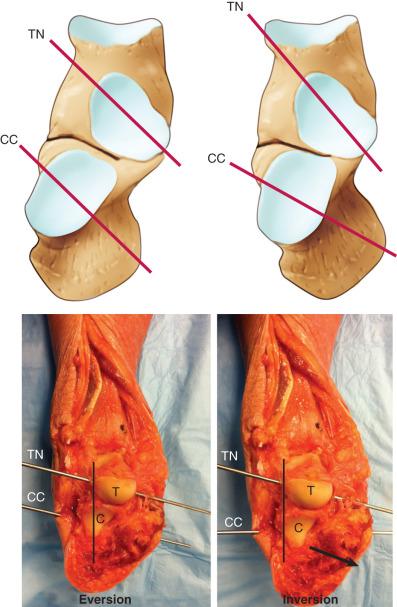
Impairment of the transverse tarsal joint impairs subtalar joint motion because, for subtalar motion to occur, rotation must occur about the talonavicular and calcaneocuboid joints. If an isolated arthrodesis of the talonavicular joint is carried out, most subtalar joint motion is lost. When performing arthrodeses in the area of the hindfoot, sparing the talonavicular joint when appropriate usually results in a more functional foot.
The function of the plantar aponeurosis during gait is often described by comparing it with the mechanics of a windlass. The plantar aponeurosis arises from the tubercle of the calcaneus and inserts into the base of the proximal phalanges ( Fig. 110.12 ). After heel rise, the metatarsophalangeal joints dorsiflex, tightening the plantar aponeurosis, as would a rope pulled around a windlass. This mechanism depresses the metatarsal heads, elevates and stabilizes the longitudinal arch, and helps bring the calcaneus into an inverted position ( Fig. 110.13 ). The inverted calcaneus causes the transverse tarsal joint axes to diverge, helping to stabilize the midfoot at toe-off.
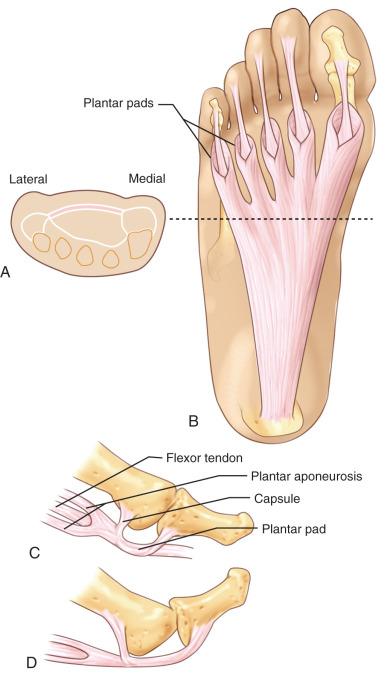
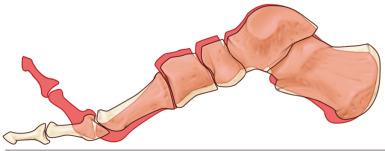
The oblique metatarsal break is created by the lateral slope formed by the increasingly proximal position of metatarsophalangeal joints two through five ( Fig. 110.14 ). This oblique line creates a camlike action after heel-rise as the body weight is brought over the metatarsal heads, inverting the hindfoot, and further enhancing external rotation of the lower extremity.
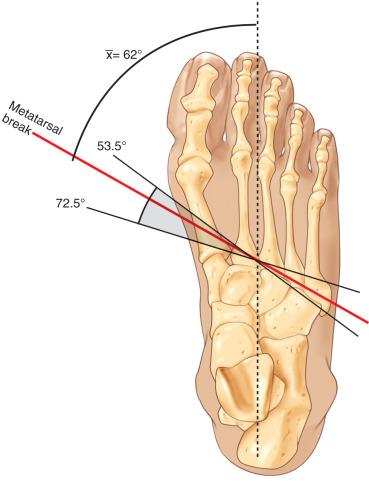
Turf-toe injuries are common in athletes and can lead to stiffness in the first metatarsophalangeal joint from arthrofibrosis or hallux rigidus, a degenerative arthritis of the first metatarsophalangeal joint. Loss of first metatarsophalangeal joint dorsiflexion prevents normal function of the windlass mechanism and metatarsal break. This situation frequently leads to external rotation of the foot during gait to relieve the stress across the involved area and can cause compensatory changes throughout the lower extremity.
Hallux valgus also alters the biomechanical function of the first ray and may contribute to altered kinematics and gait parameters throughout the lower extremity. The function of the first ray in with hallux valgus may be improved with taping. Unfortunately, gait parameters and whole limb kinematics may not be improved after hallux valgus surgery.
A complex coordinated series of movement and energy transfer involving the foot, ankle, and lower extremity allows for walking and running such that energy expenditure is minimized and stress applied to body segments is lessened. Over the gait cycle, a period of double-limb support during walking gives way to a float period with no limb support during running. Ankle, hindfoot, and forefoot mechanics combine to absorb impact at initial ground contact and provide stability as weight is borne on the forefoot. Alterations in the biomechanics of these systems can lead to reduced performance and injury.
Become a Clinical Tree membership for Full access and enjoy Unlimited articles
If you are a member. Log in here